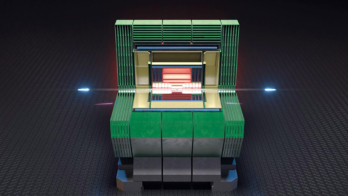The first dedicated workshop on searches for new physics in heavy-ion collisions took place at the Université Catholique de Louvain, Belgium, on 4–5 December 2018. The meeting was inspired by several recent proposals to take advantage of the unique environment of heavy-ion collisions at the LHC to search for new phenomena. A key topic was the exploration of “hidden” or “dark” sectors that couple only feebly to ordinary matter and could explain the dark-matter puzzle, neutrino masses or the matter–antimatter asymmetry of the universe. This is currently a hot topic in the search for physics beyond the Standard Model that has gained increasing interest in the heavy-ion community. The purpose of this workshop was to spark ideas and initiate exchanges between theorists, experimentalists and accelerator physicists.
A key question was how to optimise the choice of ions and the beam parameters for new-physics searches without compromising the study of the quark–gluon plasma
Discussions at the workshop first focused on particle production mechanisms unique to heavy-ion collisions. Simon Knapen from the IAS at Princeton University and Oliver Gould of the University of Helsinki emphasised the strongly enhanced production cross-sections for axion-like particles and magnetic monopoles in ultra-peripheral heavy-ion collisions compared to proton–proton collisions. This enhancement is due to the collective action of up to 82 charges (for lead ions), thereby generating the strongest electromagnetic fields ever produced in the laboratory, as the heavy ions pass each other at ultra-relativistic energies. David d’Enterria of CERN discussed the experimental potential to exploit such unique opportunities in searches for new physics by using the LHC as a “photon–photon collider”. In contrast to these studies of ultra-peripheral collisions, Glennys Farrar of New York University motivated interest in head-on collisions: thermal production in the quark–gluon plasma could be used to search for non-conventional dark-matter candidates such as “sexaquarks”.
Jan Hajer of the Université Catholique de Louvain stressed that not only the production mechanisms but also the backgrounds are qualitatively different in heavy-ion collisions. This can, for example, allow searches for long-lived particles in parameter regions that are hard to probe in proton collisions due to limitations related to the high pile-up during future LHC runs.
A key question that emerged from the workshop was how to optimise the choice of ions and the beam parameters for new-physics searches without compromising the study of the quark–gluon plasma. The discussion was extremely helpful for elucidating the hard engineering restrictions within which any novel proposals must fit, such as the capacity of the injectors and the beam lifetime.
The workshop was very successful and triggered many discussions, including the proposal to submit an input for the update of the European Strategy for Particle Physics and for a follow-up event in 2020. The topic is still young, and we are very much looking forward to input from the wider community.
Further reading
R Bruce et al. 2019 arXiv:1812.07688.





